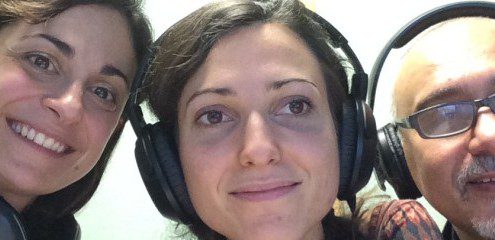Latest news at La Dante in Cambridge
Consult our blog to get latest news!

Supporting the BBC Radio Cambridgeshire and Thorpe Hall Hospice
English, Italian, SpanishLa Dante is proud to support BBC Radio Cambridgeshire, who are organising an auction to raise money for the county’s hospice Thorpe Hall. The hospice has been BBC Radio Cambridgeshire’s chosen charity partner this year, as they are raising…

Partnership with the University of Padua, Erasmus Programme
ItalianPartnerships
Discover another language and culture … be inspired!Partnership with the Department of Italian, Cambridge University
We have established a great partnership with the Department of Italian at Cambridge…

Radio Dante and bilingual families blog
English, Italian, SpanishPer le famiglie bilingui con un interesse linguistico in questo ramo La Dante ha creato un blog http://radiodantecambridge.blogspot.co.uk/ e’ pieno di articoli, referenze, consigli e aiuto per genitori e figli, per una crescita armonica che…

Unique language tandem opportunity at La Dante
English, Italian, SpanishFamiglie bilingui
We always thrive to be a bridge between Italian and English cultures and this June we have a unique and wonderful opportunity at La Dante:
A European language tandem cooking session where Italian children from a primary school…

Partnership with the Department of Italian, Cambridge University
ItalianWe have established a great partnership with the Department of Italian at Cambridge University who are happy to share their knowledge and expertise of Italian language and culture through our bilingual programmes at Radio Dante Cambridge. We…

Pinocchio alla Dante: Cambridge Italian Bilingual Group
ItalianLa Dante supports the learning of Italian for bilingual children living in Cambridge. We would like to give our children a new opportunity starting a new Pinocchio: Cambridge Italian Bilingual Groupwhich will consolidate…
More aticles below





CLIL: consigli pratici per insegnanti
ItalianEsiste una ricetta per il CLIL?
Molto è stato scritto su cosa sia la metodologia CLIL e perché utilizzarla ma esistono poche guide pratiche su come pianificare e impartire lezioni basate sul CLIL. Se sei un insegnante di materie non linguistiche a cui è stato chiesto di tenere le proprie lezioni in inglese o se sei un insegnante di lingua straniera a cui è stato chiesto di aiutare i propri colleghi ad insegnare le altre materie in lingua straniera, forse sarai alla ricerca del modo migliore per farlo. Secondo noi CLIL non significa solo trovare la ricetta perfetta ma piuttosto un viaggio avventuroso per cui partire – ma non senza alcune essenziali linee guida.
CLIL: da dove iniziare?
Ci sono alcune cose che devi assolutamente tenere in considerazione quando inizi a pianificare lezioni fondate ulla metodologia CLIL. Prima di tutto, pensa a chi sono i tuoi studenti – al loro livello di inglese (o qualunque altra lingua seconda utilizzerai per trasmettere i contenuti), alle loro conoscenze pregresse riguardo la materie che insegnerai loro, e cosa essi si aspettano dalla classe. Una volta stabilito questo, puoi iniziare ad abbozzare il programma da seguire, facendo in modo che il livello di conoscenza della lingua dei tuoi studenti sia compatibile con il contenuto e i materiali che vuoi utilizzare.
Ecco due esempi per far risaltare l’impatto che il livello di conoscenza linguistica dei tuoi studenti può avere sulle tue lezioni. Durante un corso basato sul CLIL che abbiamo tenuto in una scuola superiore italiana abbiamo avuto la possibilità di insegnare a studenti con un livello abbastanza alto di inglese. Questo ci ha permesso di focalizarci sull’aspetto del contenuto (in quel caso arte e scienze) mentre l’inglese era solo il mezzo utilizzato per tenere le lezioni. Con questi studenti abbiamo potuto adattare il materiale progettato per alunni inglesi. Abbiamo in seguito avuto un’altra esperienza in una scuola in cui il livello di inglese degli studenti era più carente. Questo ci ha obbligato a scegliere un approccio maggiormente focalizzato sugli aspetti linguistici, concentrandoci in particolare sul vocabolario relativo alle materie in questione (in tal caso educazione fisica e musica). Per questi alunni, i libri di testo destinati a madrelingua inglesi erano troppo difficili da un punto di vista linguistico, così abbiamo adattato e creato il il materiale preesistente in modo da a) insegnare concetti chiave e vocabolario riguardante educazione fisica e musica e b) sviluppare le loro abilità linguistiche, con l’obiettivo di renderli capaci di utilizzare veri libri di testo inglese durante l’ultimo anno di scuola.
Come selezionare il materiale corretto?
Un importante fattore da considerare quando si seleziona il materiale è evitare di sovraccaricare gli studenti con troppe informazioni che non sarebbero in grado di elaborare. Per farlo si può selezionare un contenuto relativamente semplice o scegliere qualcosa di cui si è già parlato nella lingua madre e utilizzare il corso fondato sul CLIL come modo per ripassare e approfondire i contenuti.
Gli insegnanti potrebbero trovare utile lavorare sui libri di testo inglesi progettati per studenti madrelingua delle scuole primarie. Ciò può avere vantaggi sia per l’insegnante che per gli studenti: dal punto di vista contenutistico, il livello di questi libri non è molto difficile ma fornisce un contesto autentico per il vocabolario di cui gli studenti avranno bisogno in seguito. Per quanto riguarda gli insegnanti, possono utilizzare esercizi già fatti per testare le conoscenze degli studenti a livello di contenuto e nel frattempo concentrarsi sullo sviluppo di ulteriori attività utili per consolidare le abilità linguistiche in lingua straniera dei loro studenti.
Risorse online per il CLIL
Internet offre numerose risorse per gli insegnanti: per esempio, il British Council e editori come Pearson hanno numerosi contenuti gratuiti online. Puoi anche dare un’occhiata al modello di una lezione sull’Induismo tenuta seguendo la metodologia CLIL qui. Potrai trovare ulteriori idee su questa pagina.
È molto importante per gli insegnanti di lingua straniera e non lavorare insieme come in un gruppo. Condividere idee e osservarsi l’un l’altro durante la lezione può davvero dare una grande spinta alle tue abilità e conoscenze riguardo al CLIL.
Per esempio, gli insegnanti di materie diverse da quelle di lingua straniera hanno una grande quantità di materiale di cui probabilmente potrai trovare equivalenti in inglese, e gli insegnanti di lingua straniera probabilmente hanno idee e suggerimenti su come sfruttare questi materiali per fini linguistici.
Analisi dei materiale e come usarli al meglio
Il vocabolario è uno dei primi aspetti da considerare –ci sono termini tecnici o specialistici che i tuoi studenti avranno bisogno di conoscere per il corso o per comprendere i testi? Se questo è il caso, assicurati di spiegarlo loro per tempo sottoponendo agli studenti esercizi in cui devono abbinare la parola a definizioni o immagini, utilizzando esercizi di completamento o aiutando gli studenti a dedurre il significato a partire dal contesto.
Idee pratiche: la tua lezione probabilmente si concentrerà sulla comprensione generale di un testo principale – rendilo più interessante utilizzando esercizi di comprensione come information gaps, jigsaw reading tasks e jumble tasks. Le attività di rinforzo possono focalizzarsi sul potenziamento del vocabolario insegnato in precedenza agli studenti e sullo sviluppo sia delle abilità linguistiche che della comprensione dell’argomento. QUeste attività possono includere discussioni di gruppo, presentazioni individuali, creazione di poster e redazione di testi sull’argomento.
Per maggiori informazioni riguardo ai nostri corsi CLIL non esitare a contattarci: english@ladante-in-cambridge.org
CLIL: consejos prácticos para profesores
Spanish¿Hay alguna receta para CLIL?
Mucho se ha escrito sobre qué es CLIL y por qué hacerlo, pero hay muy pocas guías prácticas sobre cómo planificar y enseñar CLIL. Si eres un profesor de materias al que se le ha pedido que enseñe en inglés o un profesor de idiomas al que se le ha pedido que ayude a enseñar contenido, probablemente estás buscando la mejor manera de hacerlo. En nuestra opinión, CLIL no solo trata de encontrar la receta perfecta, sino más bien un viaje de aventura en el que puede embarcarse, pero no sin algunas pautas esenciales.
CLIL: ¿por dónde empezar?
Hay algunas cosas que debes tener en cuenta cuando comiences a planear una clase CLIL. Antes que nada, piensa en quiénes son sus alumnos: su nivel de inglés (o lo que sea que sea el segundo idioma), su conocimiento previo del contenido que les va a enseñar y lo que esperan de la clase. Una vez que lo sepa, puede comenzar a delinear el programa que desea seguir, haciendo coincidir el nivel de idioma de sus estudiantes con el contenido y seleccionando los materiales para usar.
Aquí hay dos ejemplos para subrayar el impacto que el nivel de idioma de sus estudiantes podría tener en su curso. Durante un curso CLIL, nos postulábamos en Italia en una escuela secundaria, enseñamos a estudiantes que tenían un nivel bastante alto de inglés. Esto nos permitió enfocarnos más en el lado del contenido (en ese caso, Artes y Ciencia) y el idioma inglés fue solo el medio que utilizamos para impartir las clases. Con estos estudiantes, pudimos adaptar material diseñado para alumnos nativos de inglés. Luego tuvimos otra experiencia en una escuela donde el nivel de inglés de los estudiantes era bastante débil. Esto nos obligó a elegir un enfoque más orientado al lenguaje, centrándonos en el vocabulario particular relacionado con las áreas de contenido (en este caso PE y Música). Con estos alumnos, los libros de texto nativos de inglés eran demasiado difíciles desde el punto de vista lingüístico, así que adaptamos y creamos nuestros propios materiales a) para enseñar conceptos clave y vocabulario sobre PE y música y b) desarrollar sus habilidades lingüísticas, con el objetivo de permitirles utilizar libros de texto con contenido real en inglés en su último año de escuela.
¿Cómo seleccionar el material correcto?
Un factor importante a considerar al seleccionar materiales es evitar sobrecargar a los estudiantes con demasiada información que no podrán procesar. Esto se puede hacer eligiendo un área de contenido relativamente simple o usando un área que ya ha cubierto en L1 y haciendo el curso CLIL como revisión y extensión.
Los maestros podrían encontrar útil trabajar en libros de texto en inglés diseñados para escuelas primarias de inglés nativas. Esto tiene ventajas tanto para el docente como para los estudiantes: el nivel de contenido de estos libros no es demasiado difícil, pero proporciona un contexto auténtico para el vocabulario que los alumnos necesitarán más adelante. En cuanto a los profesores, pueden usar los ejercicios ya preparados para evaluar el conocimiento del contenido, mientras se enfocan en el desarrollo de actividades adicionales para consolidar las habilidades del segundo idioma de sus alumnos.
Recursos en línea para CLIL
Internet tiene muchos recursos para los docentes: por ejemplo, el British Council y editores como Pearson ofrecen contenido gratuito en línea. También puedes echar un vistazo a una muestra de una clase CLIL sobre el Induismo aquí. También encontrará más ideas en esta página.
Es muy importante que los profesores de idiomas y los profesores de contenido trabajen juntos como un equipo. Compartir ideas y observar las lecciones de los demás realmente mejorará sus habilidades CLIL.
Por ejemplo, los profesores de contenido tienen una gran cantidad de materiales en los que es posible que encuentres equivalentes en inglés, y los profesores de idiomas probablemente tengan ideas sobre cómo explotar esos materiales para fines lingüísticos.
Análisis de materiales y cómo usarlo en su mejor momento
El vocabulario es definitivamente uno de los primeros aspectos a considerar: ¿hay algún vocabulario técnico o especializado que tus estudiantes necesiten saber para el curso o para entender el texto? Si ese es el caso, asegúrese de explicarlo de antemano haciendo que los alumnos relacionen las palabras con las definiciones o imágenes, a través de ejercicios de relleno de espacio o ayudándoles a adivinar el significado del contexto.
Ideas prácticas: Su clase probablemente se enfocará en la comprensión general de un texto principal, haga que sea más interesante mediante el uso de actividades de comprensión como lagunas de información, tareas de lectura de rompecabezas y tareas confusas. Las actividades de seguimiento pueden ayudar a reforzar el vocabulario enseñado anteriormente y desarrollar tanto las habilidades del lenguaje como la comprensión del tema. Estas actividades pueden incluir discusiones en grupo, presentaciones individuales, hacer afiches y escribir sobre el tema.
Para obtener más información sobre nuestros cursos CLIL, consulte: english@ladante-in-cambridge.org
CLIL: Entrevista a los formadores de docentes de La Dante
SpanishMary Spratt y Helen Baker han llevado a cabo nuestro curso CLIL de dos semanas para un grupo de profesores de secundaria de Zaragoza, enseñaron una gran variedad de disciplinas, desde educación física hasta música y arte. Los hemos entrevistado después del final del curso.
Mary Spratt, formadora de docentes y escritora de cursos
Helen Baker, formadora de profesores y examinadora de Cambridge
Para obtener más información sobre nuestros cursos CLIL, consulte: english@ladante-in-cambridge.org
CLIL: Intervista alle insegnanti formatrici de La Dante
ItalianLe nostre docenti formatrici Mary Spratt ed Helen Baker hanno tenuto un corso CLIL di due settimane per un gruppo di insegnanti di scuola secondaria provenienti da Zaragoza, docenti di diverse discipline, tra cui educazione fisica, musica ed arte. Le abbiamo raggiunte ed intervistate alla fine del corso.
Mary Spratt, docente formatrice e autrice di numerosi corsi
Helen Baker, docente formatrice ed esaminatrice esami Cambridge
Per maggiori informazioni riguardo ai nostri corsi CLIL invia la tua richiesta a: english@ladante-in-cambridge.org
CLIL: Interviewing La Dante’s teacher trainers
English, Italian, SpanishMary Spratt and Helen Baker have run our two weeks’ CLIL course for a group of secondary teachers from Zaragoza, who taught a variety of disciplines from PE to Music and Art. We’ve interviewed them after the end of the course.
Mary Spratt, teacher trainer and course writer
Helen Baker, teacher trainer and Cambridge examiner
For more information on our CLIL courses, please enquire: english@ladante-in-cambridge.org
CLIL: practical tips for teachers
English, Italian, SpanishIs there a recipe for CLIL?
Much has been written on what CLIL is and why to do it but there is very little practical guidance on how to plan and teach CLIL lessons. If you are a subject teacher who has been asked to teach in English or a language teacher who has been asked to help teach content, you are probably looking for the best way to do it. In our opinion, CLIL is not only about finding the perfect recipe but rather an adventurous journey that you can embark on – but not without some essential guidelines.
CLIL: where to start?
There are some things you should definitely keep in mind when you start planning a CLIL lesson. First of all, think about who your students are – their level of English (or whatever the second language is), their previous knowledge of the content you are going to teach them, and what they expect from the class. Once you know that, you can start to outline the programme you want to follow, matching your students’ language level to the content and selecting the materials to use.
Here are two examples to underline the impact the language level of your students could have on your course. During a CLIL course, we ran in Italy in a secondary school, we were teaching students that had quite a high level of English. This allowed us to focus more on the content side (in that case Arts and Science) and the English language was just the means we used to deliver the classes. With these students, we were able to adapt material designed for native English pupils. Then we had another experience in a school where the students’ English level was quite weak. This forced us to choose a more language-oriented approach, focusing on the particular vocabulary related to the content areas (in this case PE and Music). With these pupils, native English textbooks were linguistically too hard, so we adapted and created our own materials a) to teach key concepts and vocabulary regarding PE and Music and b) to develop their language skills, with the goal of allowing them to be able to use real English content textbooks by their last year of school. lesson. First of all, think about who your students are – their level of English (or whatever the second language is), their previous knowledge of the content you are going to teach them, and what they expect from the class. Once you know that, you can start to outline the programme you want to follow, matching your students’ language level to the content and selecting the materials to use.
Here are two examples to underline the impact the language level of your students could have on your course. During a CLIL course, we ran in Italy in a secondary school, we were teaching students that had quite a high level of English. This allowed us to focus more on the content side (in that case Arts and Science) and the English language was just the means we used to deliver the classes. With these students, we were able to adapt material designed for native English pupils. Then we had another experience in a school where the students’ English level was quite weak. This forced us to choose a more language-oriented approach, focusing on the particular vocabulary related to the content areas (in this case PE and Music). With these pupils, native English textbooks were linguistically too hard, so we adapted and created our own materials a) to teach key concepts and vocabulary regarding PE and Music and b) to develop their language skills, with the goal of allowing them to be able to use real English content textbooks by their last year of school.
How to select the right material?
An important factor to consider when selecting materials is to avoid overloading students with too much information that they will not be able to process. This can be done by choosing a relatively simple content area or by using an area that you have already covered in L1 and doing the CLIL course as revision and extension.
Teachers could find useful to work on English textbooks designed for native English primary schools. This has advantages for both teacher and students: these books’ content level is not too hard but provides an authentic context for the vocabulary that the students will need later on. As for the teachers, they can use the ready-made exercises to test content knowledge, while focusing on the development of further activities to consolidate the second language skills of their students.
Online resources for CLIL
The internet has a lot of resources for teachers: for example, the British Council and publishers like Pearson offer free content online. You can also have a look at a sample of a CLIL lesson about Induism here. You will also find further ideas on this page.
It’s very important for language teachers and content teachers to be working together as a team. Sharing ideas and observing each other’s lessons would really boost your CLIL skills.
For example, content teachers have a huge amount of materials which you may be able to find equivalents of in English, and language teachers probably have ideas as to how to exploit those materials for language purposes.
Material analysis and how to use it at its best
Vocabulary is definitely one of the first aspects to consider – is there any technical or specialised vocabulary that your students need to know for the course, or to understand the text? If that is the case, make sure to explain it beforehand by getting students to match words to definitions or pictures, through gap-fill exercises or helping them to guess the meaning from context.
Practical ideas: your lesson will probably focus on the general comprehension of one main text – make it more interesting by using comprehension activities such as information gaps, jigsaw reading tasks and jumble tasks. Follow-up activities can work on reinforcing the vocabulary taught earlier and developing both language skills and comprehension of the topic. These activities can include group discussions, individual presentations, making posters and writing about the topic.
For more information on our CLIL courses, please enquire: english@ladante-in-cambridge.org